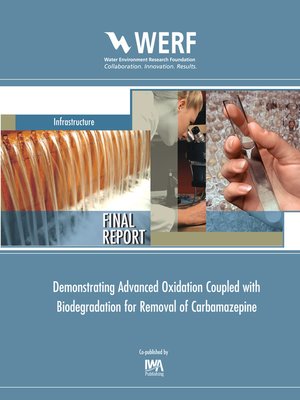Demonstrating Advanced Oxidation Coupled with Biodegradation for Removal of Carbamazepine
ebook ∣ WERF Research Report
By Nancy G. Love

Sign up to save your library
With an OverDrive account, you can save your favorite libraries for at-a-glance information about availability. Find out more about OverDrive accounts.
Find this title in Libby, the library reading app by OverDrive.



Search for a digital library with this title
Title found at these libraries:
| Library Name | Distance |
|---|---|
| Loading... |
Available as eBook only.
Carbamazepine is hydrophilic anthropogenic pharmaceutical found in wastewater effluents that is quite resistant to removal by conventional wastewater treatment processes. Hydroxyl radical-based advanced oxidation process can transform carbamazepine into degradation products but cannot mineralize it in an economically efficient manner.
This study evaluated the combination of ultraviolet plus hydrogen peroxide (UV-H2O2)-based advanced oxidation and biodegradation to enable carbamazepine removal; specifically, to determine whether the products of the advanced oxidation of carbamazepine can be further biodegraded by activated sludge microbial communities. The fate of 14C-carbamazepine was followed through bench-scale advanced oxidation followed by biodegradation using liquid scintillation counting and mass spectrometry equipped with a radiation detector. The results illustrate that carbamazepine oxidation products can be mineralized by activated sludge bacteria. This outcome suggests that combining advanced oxidation with a biologically active filtration treatment step can be effective for carbamazepine removal. This same treatment strategy should be evaluated for its effectiveness with other biologically recalcitrant organic micropollutants. Advanced oxidation followed by biodegradation may be a viable option for applying tertiary wastewater treatment to achieve trace contaminant removal.
Carbamazepine is hydrophilic anthropogenic pharmaceutical found in wastewater effluents that is quite resistant to removal by conventional wastewater treatment processes. Hydroxyl radical-based advanced oxidation process can transform carbamazepine into degradation products but cannot mineralize it in an economically efficient manner.
This study evaluated the combination of ultraviolet plus hydrogen peroxide (UV-H2O2)-based advanced oxidation and biodegradation to enable carbamazepine removal; specifically, to determine whether the products of the advanced oxidation of carbamazepine can be further biodegraded by activated sludge microbial communities. The fate of 14C-carbamazepine was followed through bench-scale advanced oxidation followed by biodegradation using liquid scintillation counting and mass spectrometry equipped with a radiation detector. The results illustrate that carbamazepine oxidation products can be mineralized by activated sludge bacteria. This outcome suggests that combining advanced oxidation with a biologically active filtration treatment step can be effective for carbamazepine removal. This same treatment strategy should be evaluated for its effectiveness with other biologically recalcitrant organic micropollutants. Advanced oxidation followed by biodegradation may be a viable option for applying tertiary wastewater treatment to achieve trace contaminant removal.







